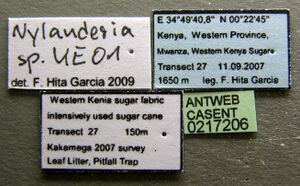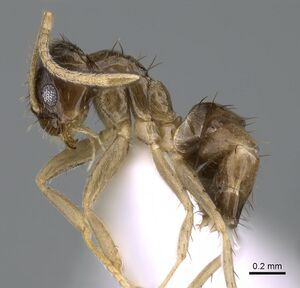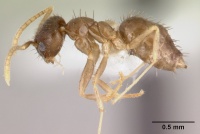Nylanderia boltoni
| Nylanderia boltoni | |
|---|---|

| |
| Scientific classification | |
| Kingdom: | Animalia |
| Phylum: | Arthropoda |
| Class: | Insecta |
| Order: | Hymenoptera |
| Family: | Formicidae |
| Subfamily: | Formicinae |
| Tribe: | Lasiini |
| Genus: | Nylanderia |
| Species: | N. boltoni |
| Binomial name | |
| Nylanderia boltoni LaPolla & Fisher, 2011 | |
This species has one of the widest ranges of any Afrotropical Nylanderia (the other being Nylanderia jaegerskioeldi) being found in West, East and South Africa. Taylor et al. (2018) report this species as nesting in leaf litter and in dead wood on the soil, as well as under bark on living trees. Found foraging on cocoa, where it was quite common, on 0.1-1.0% of cocoa trees, tending aphids and perhaps building debris tents. Also found foraging on the soil, oil palm, coffee and on mango (Mangifera indica) trees.
Identification
LaPolla et al. (2011) - Head width less than 0.48 mm; yellowish-brown to brown species, with very short, angular propodeal dorsal face; mesocoxae and metacoxae lighter than procoxae in color.
Compare with: Nylanderia scintilla and Nylanderia umbella
This species is most likely to be confused with N. umbella and N. scintilla. It can be separated from N. umbella by the fact that N. umbella is a much darker brown species, with distinctly contrasting yellowish-brown mesocoxae and metacoxae. The distinction between Nylanderia boltoni and N. scintilla can be more difficult, but in N. scintilla the coxae are the same color.
Keys including this Species
Distribution
Latitudinal Distribution Pattern
Latitudinal Range: 7.3675° to -25.04141°.
| North Temperate |
North Subtropical |
Tropical | South Subtropical |
South Temperate |
- Source: AntMaps
Distribution based on Regional Taxon Lists
Afrotropical Region: Benin, Gabon (type locality), Ghana, Kenya, Nigeria, South Africa, Uganda, United Republic of Tanzania.
Distribution based on AntMaps
Distribution based on AntWeb specimens
Check data from AntWeb
Countries Occupied
| Number of countries occupied by this species based on AntWiki Regional Taxon Lists. In general, fewer countries occupied indicates a narrower range, while more countries indicates a more widespread species. |

|
Estimated Abundance
| Relative abundance based on number of AntMaps records per species (this species within the purple bar). Fewer records (to the left) indicates a less abundant/encountered species while more records (to the right) indicates more abundant/encountered species. |

|
Biology
Castes
Images from AntWeb
   
| |
| Worker. Specimen code casent0217206. Photographer Estella Ortega, uploaded by California Academy of Sciences. | Owned by CAS, San Francisco, CA, USA. |
   
| |
| Worker. Specimen code casent0281154. Photographer Cerise Chen, uploaded by California Academy of Sciences. | Owned by PSWC, Philip S. Ward Collection. |
   
| |
| Worker. Specimen code casent0317035. Photographer Estella Ortega, uploaded by California Academy of Sciences. | Owned by CAS, San Francisco, CA, USA. |
   
| |
| Paratype of Nylanderia boltoni. Worker. Specimen code casent0339203. Photographer Estella Ortega, uploaded by California Academy of Sciences. | Owned by CAS, San Francisco, CA, USA. |
Nomenclature
The following information is derived from Barry Bolton's Online Catalogue of the Ants of the World.
- boltoni. Nylanderia boltoni LaPolla & Fisher, in LaPolla, Hawkes & Fisher, 2011: 14, figs. 1-3, 73, 89-91 (w.m.) GABON.
Unless otherwise noted the text for the remainder of this section is reported from the publication that includes the original description.
LaPolla et al. (2011) - LaPolla et al. (2011) - This species has one of the widest ranges of any Afrotropical Nylanderia (the other being Nylanderia jaegerskioeldi) being found in West, East and South Africa. Given this large range, spanning several bioclimatic regions, there are some questions as to conspecificity, but the workers from all regions are morphologically very similar to each other, with minor variations noted in color. Males are only known from the Ghana specimens (which were in particularly poor condition) and more collecting of nest series from across the species range would be informative.
Description
Worker
Measurements (n = 4): TL: 1.8–2.3; HW: 0.40–0.47; HL: 0.52–0.61; EL: 0.12–0.15; SL: 0.52–0.64; PW: 0.29–0.37; WL: 0.56–0.69; GL: 0.76–1.0
Indices: CI: 77–81; REL: 22–25; SI: 121–136
Overall yellowish brown, with lighter brown to yellow mandibles, antennae, and legs; head and gaster typically darker brown than mesosoma, although in some specimens the mesosoma is the same color as the head and gaster, or just the anterior portion of the pronotum is the same color; cuticle smooth and shining; coxae may be entirely yellowish-brown in color; in some specimens mesocoxae and metacoxae slightly lighter in color than procoxae. Head with a dense layer of pubescence; scapes surpass posterior margin by about the length of the first two funicular segments; scapes with scattered erect macrosetae and a dense layer of pubescence (SMC = 13–16); posterior margin with rounded posterolateral corners, slightly emarginate medially. Mesosoma with erect macrosetae of varying lengths concentrated on posterior pronotum and mesonotum (PMC = 2–4; MMC = 2–4); pubescence scattered across mesosomal notum; metanotal area compact; dorsal face of propodeum angular and low (lower than mesonotum) with very short dorsal face and longer declivitous face; propodeal dorsum with pubescence; declivity smooth and shining with no pubescence. Gaster with erect macrosetae and a dense layer of pubescence.
The queen caste is currently unknown for this species.
Male
Measurements (n = 1): TL: 2.0; HW: 0.48; HL: 0.48; EL: 0.22; SL: 0.56; PW: 0.42; WL: 0.78; GL: 0.78 Indices: CI: 100; REL: 45; SI: 117
Overall head and gaster light brown, with lighter brown to yellowish-brown antennae, mesosoma, tibia and tarsi; cuticle smooth and shining with short appressed pubescence on head, dorsal mesosoma and gaster with slightly longer pubescence. Compound eyes strongly convex (more than half the length of the lateral margin), with raised ocelli. Scapes surpass posterior margin by about length of first four funicular segments; scapes with sparsely scattered erect macrosetae (SMC = 2–4) and short appressed pubescence. Mandible with small, but distinct, apical tooth, margin emarginate behind, followed by a small, indistinct denticle; basal angle distinct. Mesosoma with short, appressed pubescence and scattered erect macrosetae (PMC = 0; MMC = 7–9) dorsally; dorsal face slightly sloped, well below level of mesonotum; dorsal face and declivitous face about the same length. Gaster with longer pubescence than on mesosoma and scattered suberect and erect macrosetae. Genitalia: parameres broadly rounded at apices curving dorsally (such that they obscure some of the genitalia in dorsal view); apical margin of parameres emarginate; ventral margin of parameres at an acute angle; cuspi elongated, apices rounded with peg-like teeth on ental surface where they meet digit; digiti apices broad; peg-like teeth at apices dorsally, ventrally coming to a narrow point that curves towards parameres.
Type Material
Holotype worker, GABON: F.C. Mondah, 21 km 331° NNW Libreville, 00°34'36" N, 009°20'06" E, elev. 10 m; 24.ii.1998 (B.L. Fisher) (California Academy of Sciences) (CASENT0179580); 1 paratype worker, same label data as holotype (National Museum of Natural History); 1 paratype worker, CENTRAL AFRICAN REPUBLIC: P.N. Dzanga-Nodki, 21.4km 53 NE Bayanga, 3 02.01’N, 16 24.57’E, 510 m, 1–7.v.2001 (S. van Noort) (USNM).
Etymology
Named to honor Barry Bolton (retired – Natural History Museum, London) for his truly exceptional contributions to ant systematics and for his kind support of JSL and BLF over the years. It seems to us especially fitting to name an African ant species after Barry because he has contributed enormously to our understanding of African ant systematics through his many publications on the topic.
References
- LaPolla, J.S., Hawkes, P.G. & Fisher, B.L. (2011) Monograph of Nylanderia (Hymenoptera: Formicidae) of the World, Part I: Nylanderia in the Afrotropics. Zootaxa 3110: 10–36.
- Taylor, B., Agoinon, N., Sinzogan, A., Adandonon, A., Kouaguou, Y. N., Bello, S., Wargui, R., Anato, F., Ouagoussounon, I., Houngbo, H., Tchibozo, S., Todjihounde, R., Vayssieres, J.F. 2018. Records of ants (Hymenoptera: Formicidae) from the Republic of Benin, with particular reference to the mango farm ecosystem. Journal of Insect Biodiversity 8(1): 6-29 (doi:10.12976/jib/2018.08.1.2).
References based on Global Ant Biodiversity Informatics
- Garcia F.H., Wiesel E. and Fischer G. 2013.The Ants of Kenya (Hymenoptera: Formicidae)Faunal Overview, First Species Checklist, Bibliography, Accounts for All Genera, and Discussion on Taxonomy and Zoogeography. Journal of East African Natural History, 101(2): 127-222
- Kouakou L. M. M., K. Yeo, K. Ouattara, W. Dekoninck, T. Delsinne, and S. Konate. 2018. Investigating urban ant community (Hymenoptera: Formicidae) in port cities and in major towns along the border in Côte d’Ivoire: a rapid assessment to detect potential introduced invasive ant species. Journal of Animal and Plant Sciences 36(1): 5793-5811.
- LaPolla J. S.; P.G. Hawkes, and B.L. Fisher. 2011. Monograph of Nylanderia (Hymenoptera: Formicidae) of the World, Part I: Nylanderia in the Afrotropics. Zootaxa 3110: 10-36.
- Taylor B., N. Agoinon, A. Sinzogan, A. Adandonon, Y. N'Da Kouagou, S. Bello, R. Wargui, F. Anato, I. Ouagoussounon, H. Houngbo, S. Tchibozo, R. Todjhounde, and J. F. Vayssieres. 2018. Records of ants (Hymenoptera: Formicidae) from the Republic of Benin, with particular reference to the mango farm ecosystem. Journal of Insect Biodiversity 8(1): 006–029.

